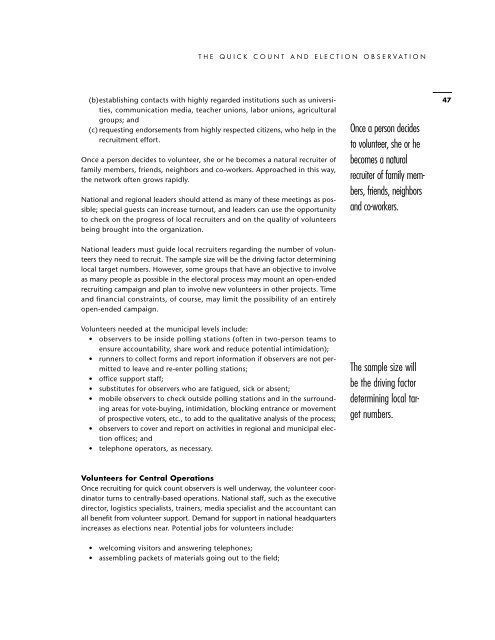The Quick Count and Election Observation
The Quick Count and Election Observation
The Quick Count and Election Observation
Create successful ePaper yourself
Turn your PDF publications into a flip-book with our unique Google optimized e-Paper software.
THE QUICK COUNT AND ELECTION OBSERVATION<br />
(b)establishing contacts with highly regarded institutions such as universities,<br />
communication media, teacher unions, labor unions, agricultural<br />
groups; <strong>and</strong><br />
(c) requesting endorsements from highly respected citizens, who help in the<br />
recruitment effort.<br />
Once a person decides to volunteer, she or he becomes a natural recruiter of<br />
family members, friends, neighbors <strong>and</strong> co-workers. Approached in this way,<br />
the network often grows rapidly.<br />
National <strong>and</strong> regional leaders should attend as many of these meetings as possible;<br />
special guests can increase turnout, <strong>and</strong> leaders can use the opportunity<br />
to check on the progress of local recruiters <strong>and</strong> on the quality of volunteers<br />
being brought into the organization.<br />
Once a person decides<br />
to volunteer, she or he<br />
becomes a natural<br />
recruiter of family members,<br />
friends, neighbors<br />
<strong>and</strong> co-workers.<br />
47<br />
National leaders must guide local recruiters regarding the number of volunteers<br />
they need to recruit. <strong>The</strong> sample size will be the driving factor determining<br />
local target numbers. However, some groups that have an objective to involve<br />
as many people as possible in the electoral process may mount an open-ended<br />
recruiting campaign <strong>and</strong> plan to involve new volunteers in other projects. Time<br />
<strong>and</strong> financial constraints, of course, may limit the possibility of an entirely<br />
open-ended campaign.<br />
Volunteers needed at the municipal levels include:<br />
• observers to be inside polling stations (often in two-person teams to<br />
ensure accountability, share work <strong>and</strong> reduce potential intimidation);<br />
• runners to collect forms <strong>and</strong> report information if observers are not permitted<br />
to leave <strong>and</strong> re-enter polling stations;<br />
• office support staff;<br />
• substitutes for observers who are fatigued, sick or absent;<br />
• mobile observers to check outside polling stations <strong>and</strong> in the surrounding<br />
areas for vote-buying, intimidation, blocking entrance or movement<br />
of prospective voters, etc., to add to the qualitative analysis of the process;<br />
• observers to cover <strong>and</strong> report on activities in regional <strong>and</strong> municipal election<br />
offices; <strong>and</strong><br />
• telephone operators, as necessary.<br />
<strong>The</strong> sample size will<br />
be the driving factor<br />
determining local target<br />
numbers.<br />
Volunteers for Central Operations<br />
Once recruiting for quick count observers is well underway, the volunteer coordinator<br />
turns to centrally-based operations. National staff, such as the executive<br />
director, logistics specialists, trainers, media specialist <strong>and</strong> the accountant can<br />
all benefit from volunteer support. Dem<strong>and</strong> for support in national headquarters<br />
increases as elections near. Potential jobs for volunteers include:<br />
• welcoming visitors <strong>and</strong> answering telephones;<br />
• assembling packets of materials going out to the field;


